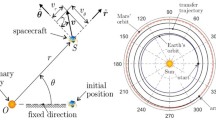Abstract
This paper investigates the optimal transfer trajectories from a circular parking orbit towards the apocenter of a rectilinear ellipse, where the spacecraft reaches a quasi-stationary condition relative to an inertial reference frame. The spacecraft is equipped with a propulsion system that provides a circumferential continuous propulsive acceleration, that is, an acceleration whose direction is perpendicular to the primary body-spacecraft line. The performance index to minimize is the total flight time, and an indirect method is used to analyze the transfer trajectories. In this context, the optimal transfer performance is obtained as a function of the spacecraft propulsive acceleration magnitude through an interpolation procedure of numerical simulations. The results obtained with a continuous thrust propulsion system are also compared with those derived from a multi-impulse transfer. Finally, the paper investigates a heliocentric mission scenario in which the spacecraft minimizes the flight time required to reach a rectilinear ellipse with a given value of the aphelion radius.
Similar content being viewed by others
Change history
11 February 2022
A Correction to this paper has been published: https://doi.org/10.1007/s42064-022-0136-2
References
Tsien, H. S. Take-off from satellite orbit. Journal of the American Rocket Society, 1953, 23(4): 233–236.
Battin, R. H. An introduction to the mathematics and methods of astrodynamics, revised edition. AIAA, 1999, 408–418.
Petropoulos, A. E., Sims, J. A. A review of some exact solutions to the planar equations of motion of a thrusting spacecraft. In: Proceedings of the 2nd International Symposium on Low-Thrust Trajectory (LoTus-2), 2002.
Niccolai, L., Quarta, A. A., Mengali, G. Orbital motion approximation with constant circumferential acceleration. Journal of Guidance, Control, and Dynamics, 2018, 41(8): 1783–1789.
Bombardelli, C., Baù, G., Peláez, J. Asymptotic solution for the two-body problem with constant tangential thrust acceleration. Celestial Mechanics and Dynamical Astronomy, 2011, 110(3): 239–256.
Quarta, A. A., Mengali, G. Analysis of spacecraft motion under constant circumferential propulsive acceleration. Acta Astronautica, 2014, 105(1): 278–284.
Roy, A. E. Orbital motion. Advances in Design and Control, 2005, 87–89.
Dandouras, I., Pirard, B., Prado, J. Y. High performance solar sails for linear trajectories and heliostationary missions. Advances in Space Research, 2004, 34(1): 198–203.
Mengali, G., Quarta, A. A. Optimal heliostationary missions of high-performance sailcraft. Acta Astronautica, 2007, 60(8–9): 676–683.
Quarta, A. A., Mengali, G. Solar sail capabilities to reach elliptic rectilinear orbits. Journal of Guidance, Control, and Dynamics, 2011, 34(3): 923–927.
Quarta, A. A., Mengali, G. Optimal solar sail transfer to linear trajectories. Acta Astronautica, 2013, 82(2): 189–196.
Colombo, G., Lautman, D. A., Pettengill, G. An alternative option to the dual-probe out-of-ecliptic mission via Jupiter swingby. In: Proceedings of Symposium on the Study of the Sun and Interplanetary Medium in Three Dimensions, 1976, 37–47.
Mengali, G., Quarta, A. A., Romagnoli, D., Circi, C. H2-reversal trajectory: a new mission application for high-performance solar sails. Advances in Space Research, 2011, 48(11): 1763–1777.
Zeng, X. Y., Baoyin, H. X., Li, J. F., Gong, S. P. New applications of the H-reversal trajectory using solar sails. Research in Astronomy and Astrophysics, 2011, 11(7): 863–878.
Bryson, A. E., Ho, Y. C. Applied optimal control. Hemisphere, 1975, 71–89.
Stengel, R. F. Optimal control and estimation. Dover Publications, 1994, 222–254.
Mengali, G., Quarta, A. A. Optimal three-dimensional interplanetary rendezvous using nonideal solar sail. Journal of Guidance, Control, and Dynamics, 2005, 28(1): 173–177.
Shampine, L. F., Gordon, M. K. Computer solution of ordinary differential equations: the initial value problem. W. H. Freeman & Company, 1975, 72(460): 155.
Shampine, L. F., Reichelt, M. W. The MATLAB ODE suite. SIAM Journal on Scientific Computing, 1997, 18(1): 1–22.
Sims, J. A., Flanagan, S. N. Preliminary design of low-thrust interplanetary missions. In: Proceedings of the AAS/AIAA Astrodynamics Specialist Conference and Exhibit, 1999, 99–338.
Author information
Authors and Affiliations
Corresponding author
Additional information
Andrea Caruso received his B.S. and M.S. degrees in aerospace engineering from University of Pisa, in 2013 and 2016, respectively. He is currently a Ph.D. student at the University of Pisa. His research interests are in spaceflight mechanics and spacecraft trajectory optimization.
Alessandro A. Quarta received his Ph.D. degree in aerospace engineering from the University of Pisa, in 2005, and is currently Professor of Flight Mechanics at the Department of Civil and Industrial Engineering of the University of Pisa. His main research areas include spaceflight simulation, spacecraft mission analysis and design, low-thrust trajectory optimization, solar sail and E-sail dynamics and control.
Giovanni Mengali received his doctor engineer degree in aeronautical engineering, in 1989, from the University of Pisa. Since 1990, he has been with the Department of Aerospace Engineering (now Department of Civil and Industrial Engineering) of the University of Pisa, first as a Ph.D. student, then as an assistant and an associate professor. Currently, he is Professor of Space Flight Mechanics. His main research areas include spacecraft mission analysis, trajectory optimization, solar sails, electric sails and aircraft flight dynamics and control.
Rights and permissions
About this article
Cite this article
Quarta, A.A., Mengali, G. & Caruso, A. Optimal circle-to-rectilinear orbit transfer with circumferential thrust. Astrodyn 3, 31–43 (2019). https://doi.org/10.1007/s42064-018-0034-9
Received:
Accepted:
Published:
Issue Date:
DOI: https://doi.org/10.1007/s42064-018-0034-9




